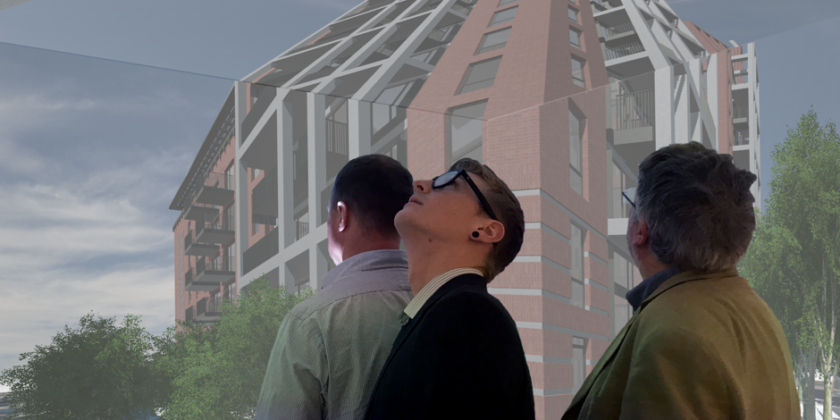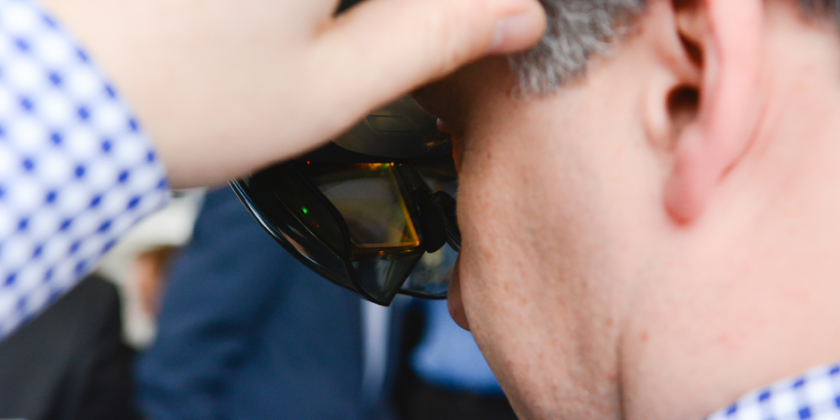Building the future of construction: Fulcro in the VR environment
Created to promote the benefits of immersive technology for the construction sector, the FULmax CUBE has been designed to allow project teams to access BIM data in virtual environments and view detailed project designs at life-size. Using Microsoft HoloLens head-mounted AR displays, participants are also taken ‘on-site’ for an immersive site overview.
The Dudley College Advance II building is the world’s first to be built using the Integrated Project Insurance (IPI) model of procurement detailed in the Building Information Modelling (BIM) Level 2 schema. Fulcro Engineering Services’ pioneering applied technologies ensured the first students were admitted by September 2017.
Creating a new concept for construction
The project objectives were simple, explains FULCRO Group’s Director of Applied Technologies, Dr Max Mallia-Parfitt, a former academic who entered the enterprise world from the University of Reading. “We wanted to improve the quality of processes and design delivery, get more engagement from stakeholders and on-site teams, and change on-site mentality by using immersive models to give all stakeholders an insight into the completed design.” All with the end result of delivering build-ready models.
Using the company’s bespoke technology, the FULmax CUBE, designed to fit any office space or site cabin, teams of up to six people can access BIM data in virtual environments and view detailed project designs at life-size. Stakeholders in the Dudley College project were also taken ‘on site’ at events, using the Microsoft HoloLens head-mounted AR display to give an immersive view not possible using traditional methods. Using these tools for visualisation, participants can see how the design works as a whole, and contractors are less likely to go ‘off-model’ and make their own adjustments in the building phase, explains Max.
“The problem in the past is that contractors have not been given enough information, or the incorrect information. This leads to problems further down the line in the physical building work, which is more expensive to fix than at the design stage. There is a need to break down the traditional barriers in the construction industry, as traditional methods do not work in a digital age.”
— Dr Max Mallia-Parfitt, FULCRO
It’s a claim backed up by the construction industry itself, acknowledging that modernisation is one of its biggest challenges, with the title of the 2016 Farmer Review, Modernise or Die, highlighting the point. The Co-Chair of the construction Leadership Council, Andrew Wolstenholme OBE, says that the “future of the industry depends on having a skills base that is equipped to meet the challenges of productivity, as well as competition from international and cross-sector disruptors”, adding that the sector needs to embrace “innovative and digital forms of training, most prominently immersive learning, to truly modernise”.
Building the technology
The cave automatic virtual environment, CAVE, is an immersive VR environment created by projecting images on between three and six of the walls of a room-sized cube. The concept was launched in 1992 by the University of Illinois, and the name is also a play on Plato’s allegory of the Cave in The Republic, where man contemplates perception, reality and illusion.
The technology has developed considerably since the 1990s and the concept no longer needs 12 computers to run it. Costs have also fallen considerably in that time. The first CAVE at the University of Reading cost £1.6m to build several years ago, Max reveals, today this technology comes in at under £100,000.
“Many of the ‘BIM CAVE’ designs have come from the gaming and entertainment industries, from companies such as Igloo Vision and Soluis,” Max explains. “But the technology we’ve built into our CUBE concept has been specifically developed for the construction industry, such as having a roof; as you need to be able to look upwards as you would in the real world.”

During his time at the University of Reading, Max developed a portable BIM CAVE prototype for Crossrail, which was used for 18 months and enabled collaboration between its teams and the London Fire Brigade, planning for site construction, safety procedures and on-site personnel training. Funded back then with an investment of £20,000 from the Innovate18 programme, interest began to grow in commercialising the technology for use in the wider construction industry and Max left the academic environment to join FULCRO Group.
Within the FULmax CUBE solution, Fulcro can display vast amounts of data and design detail, as well as natively playback 360° video. “We can scan an entire environment and recreate it anywhere in the World there is a BIM CAVE” says Max. This has huge implications for site safety and control, as well as advance planning. For example, if an incident occurs, it is possible to view the site exactly as it was at the time using the visualisation tools.
“We’re seeing this application working in lots of different environments”, he says, including projects that are being used to grow public engagement, and show local communities what finished building designs will actually look like. Using this technology, it is possible to show people how a building will appear from the window of their bedroom for example.
Reducing costs through improved efficiencies
Advances in technology have made all of this possible – and not all of those advances come at a high price. One of the best purchases ever made by Fulcro, reveals Max, was a Samsung 360° video camera, bought off the shelf for £320. It allows the teams to scan an environment to create a ‘digital twin’, a 3D model that matches the built environment to millimetre accuracy.
Using this camera and the FULmax CUBE, Fulcro created a digital twin for the Dudley College Advance II building, providing full transparency for future maintenance and building work through detailed images of inner construction, pipework and electrical details and removing the need for additional surveys. An operator was able to survey the entire five storey building in two site visits, then use a hand-held laser distance finder to identify potential issues to resolve back in the office. Those two visits saved 10 to 20 additional site visits and the camera paid for itself 50 times over on just one job.
“If you procure the right data at the start of a project, you can do anything with it,” says Max. “Having a digital twin allows teams to maintain a building more efficiently and effectively for the duration of its lifetime, right through to the end. Because when it’s time for the building to come down, you know exactly how much construction material you will be dealing with.”
Meeting the challenges
One of the challenges of the technology however is the current limitation of head-mounted displays. Growing hugely in popularity, they are great for providing a single user experience, explains Max, but construction is a collaborative industry. They can also cause motion sickness and further barriers to adoption include both financial and technical reasons.
However, the main challenge within the sector comes from traditionalists in the industry who are resistant to change, a challenge that Fulcro, according to Max, is determined to tackle. “We want to bring a new ethos and step change away from the old ways. One of the biggest problems in this sector is that innovation is being killed. New entrants coming into the industry are keen to do things in a different way but they’re being told they can’t do them.”
But change may already be underway. A white paper exploring the provision of immersive learning within the sector lists benefits that include enhancing the industry’s appeal for young people and investors, developing improved collaboration and communication skills and improving safety and cost-effectiveness. In his foreword for A New Reality: Immersive Learning in Construction, Andrew Wolstenholme says the “industry is shifting towards more digital design, more offsite manufacture and smarter assets – we need to attract and develop a workforce to meet these challenges.”
The new technology is already having a big impact, as Max explains. “While we are still contractually obliged to deliver designs as 2D drawings, we can now overlay 3D models onto paper drawings using tablets to provide enhanced visualisation. We don’t have to shut down sites any more for training inductions, instead we can take inductees into VR sites for training where they can safely access dangerous environments. We can speed up the time it takes to achieve proficiency in a task by starting the training in a VR simulator, which also enables us to track progress and monitor performance.”
Key players in the field believe this won’t be about replacing the old methods, but rather using the new to enhance them. Richard Whiting from Hire Association Europe believes that “by using virtual reality, we can provide training where employers won’t have to pay for workers to go offsite, but can learn about tools in an interactive environment. This doesn’t mean they won’t train using the real thing, but it means less time is needed for training on the equipment, therefore saving time and cost”.
The key impact on the sector will be to bring greater transparency to the process, to bring stakeholders into the process much earlier and to manage re-work and risk, the biggest costs of any project, according to Max. “Traditional models work on a ‘Design, Build, Test, Fix’ concept,” he explains. “The new model we’re working towards changes the order – ‘Design, Test, Fix, Build’. Using the technology available we’re showing a marked improvement in moderating spends, while not having to re-work things so much in future phases.”
And what of the future?
Max believes that we will see the rise of augmented reality in this space, and entire-process systems that cover everything from initial site sketches to raising invoices and paying contractors automatically. Costs will reduce as risks are minimised from the start of the process.
Technology visualisation goes hand in hand with smart building technology and there will be rising awareness of the impact of buildings on communities, on infrastructure and services. As buildings are created to become more intelligent, they will also become more efficient and sustainable.
“With the rise of IoT devices (Internet of Things) and ever more interconnected systems we are able to more accurately predict and react to how spaces are used, especially when the original plan for the space is often drastically different to the final use once a building is completed,” says Max. “So, visualisation technologies such as virtual and augmented realities will increase in use, helping users understand the built environment around them.”
